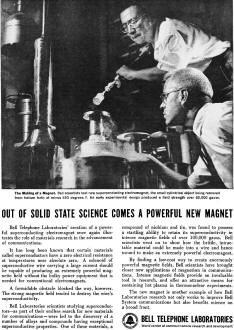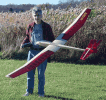|
February 1962 Radio-Electronics
 [Table of Contents] [Table of Contents]
Wax nostalgic about and learn from the history of early electronics.
See articles from Radio-Electronics,
published 1930-1988. All copyrights hereby acknowledged.
|
In researching the use
of niobium's use in superconducting magnets, as reported in this 1962 issue of
Radio-Electronics magazine, I learned that the element's original name
was Columbium (symbol Cb). It was the name assigned by discoverer
Charles Hatchett in
1801. The name niobium was chosen for element 41 at the 15th Conference of the
Union of Chemistry in Amsterdam in 1949. Why "niobium," you might
wonder? Its root is in Greek mythology, and concerns the family of Tantalus
(after whom the element tantalum is named). Niobium is today used, amongst many
other things, in the making of superconducting magnets, including those in
MRI
machines. As is often the case in photos of personnel in work environments prior
to the creation of OSHA in 1971, there is a glaring lack of safety equipment and
precautions here in this Bell Telephone Laboratories image of the scientists
handling their superconducting brew. No safety glasses, no gloves, neckties
outside a protective lab coat (also missing), and probably wearing
slick-bottomed shoes that have no traction if a liquid is slopped onto the
floor. The guys seem to be somewhat precariously perched next to and over the
crucible containing what is likely liquid nitrogen for cooling the magnet. I'm
sure you could spot other violations if you inspect a little more. It's a wonder
anyone survived before OSHA [sarcasm].
Bell Telephone Laboratories Ad
 The Making of a Magnet The Making of a Magnet
Bell scientists test new superconducting electromagnet, the small cylindrical
object being removed from helium bath at minus 450 degrees F. An early experimental
design produced a field strength over 65,000 gauss.
Out of Solid State Science Comes a Powerful New Magnet
Bell Telephone Laboratories' creation of a powerful superconducting electromagnet
once again illustrates the role of materials research in the advancement of communications.
It has long been known that certain materials called superconductors have a zero
electrical resistance at temperatures near absolute zero. A solenoid of superconductive
wire carrying a large current should be capable of producing an extremely powerful
magnetic field without the bulky power equipment that is needed for conventional
electromagnets.
A formidable obstacle blocked the way, however. The strong magnetic field tended
to destroy the wire's superconductivity.
Bell Laboratories scientists studying superconductors - as part of their endless
search for new materials for communications - were led to the discovery of a number
of alloys and compounds having exceptional superconductive properties. One of these
materials, a compound of niobium and tin, was found to possess a startling ability
to retain its superconductivity in intense magnetic fields of over 100,000 gauss.
Bell scientists went on to show how the brittle, intractable material could be made
into a wire and hence wound to make an extremely powerful electromagnet.
By finding a low-cost way to create enormously powerful magnetic fields, Bell
scientists have brought closer new applications of magnetism in communications.
Intense magnetic fields provide an invaluable tool in research, and offer an attractive
means for containing hot plasma in thermonuclear experiments.
The new magnet is another example of how Bell Laboratories research not only
works to improve Bell System communications but also benefits science on a broad
front.
Bell Telephone Laboratories
World center of communications research and development
|




























